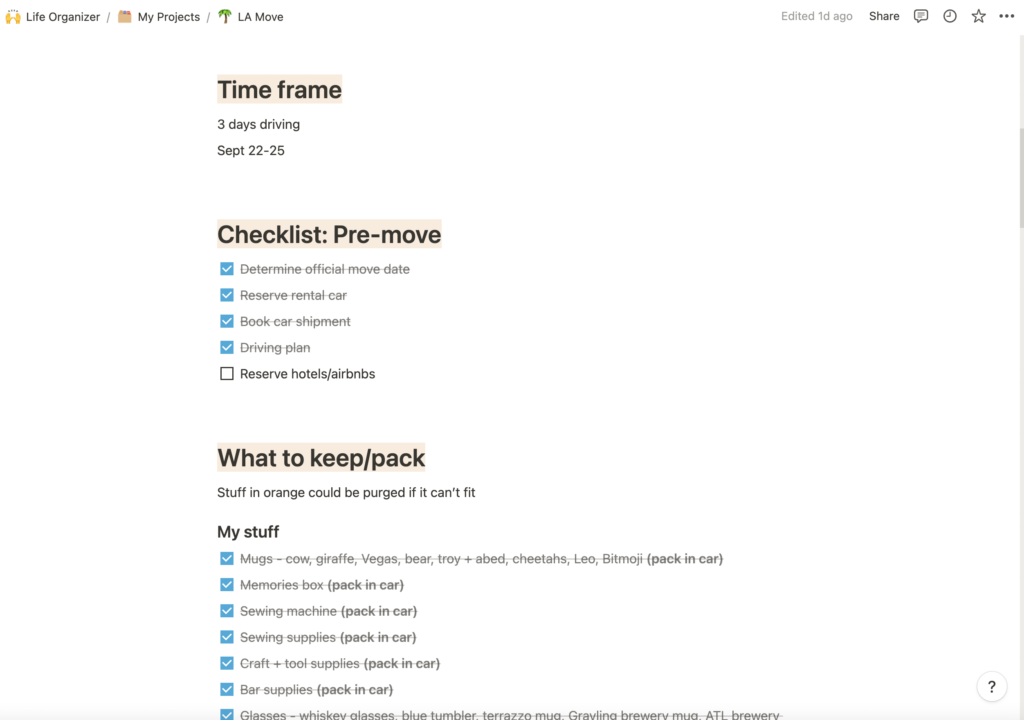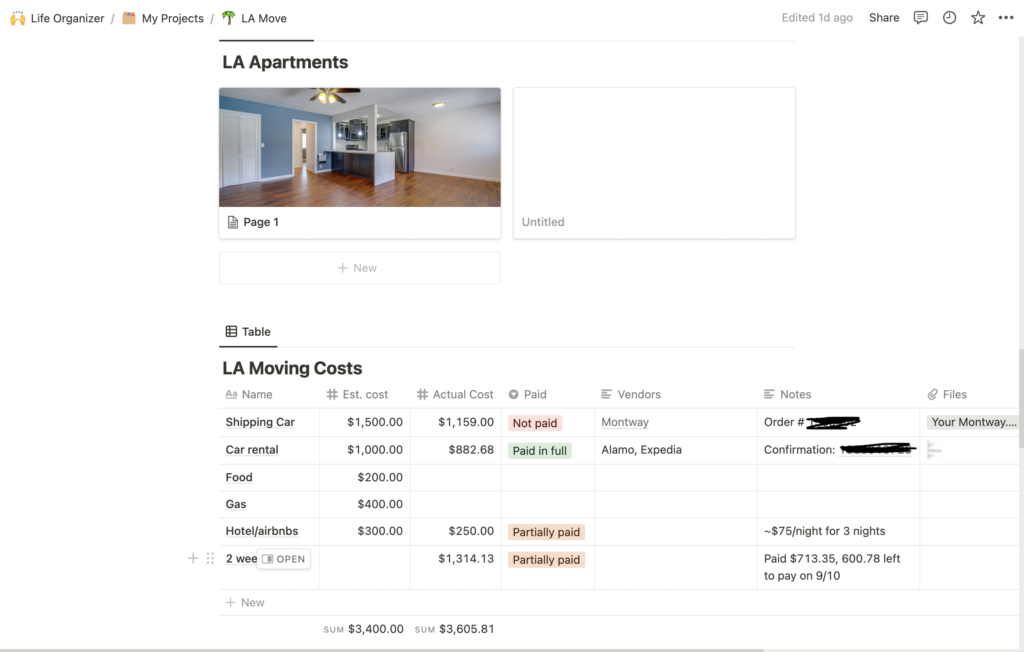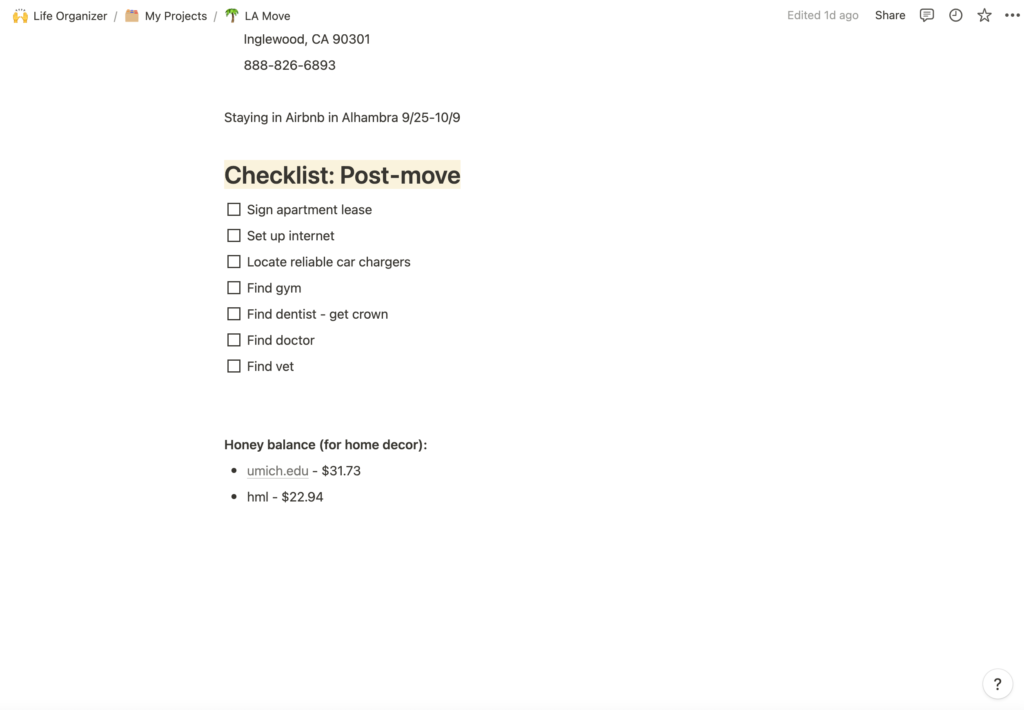Moving is hard. There’s no subjectivity about it. Packing up all your things, all the logistics, taking time off work, finding a new apartment. And that’s just scratching the surface. And then when it’s a cross-country move, it becomes infinitely harder. Take the difficulty of a move and multiply it by like 10 at least.
Lucky for you, I’m a total moving pro. In my life, I’ve probably moved no less than 15 times. And I’m about to tackle my second cross-country move. I moved from Michigan to Atlanta a little under four years ago. And in just a few days, we’ll be hitting the road on the way to Los Angeles. And we’re doing it big: selling almost everything and starting over from scratch. Let me tell you, this is a practice in letting go and welcoming change.
Quick sappy note: I will look back so fondly on my time here in Atlanta. This is where homey homies got its start. And without my first shitty little apartment in Old Fourth Ward where I got to really experiment with my style, this blog probably wouldn’t exist. So I’m excited to bring homey homies to the west coast, but Atlanta will always be the part of the HH DNA.
But enough about me, let’s get back into why you’re all here: cross-country moving tips.
So, I think I have a little moving cred, given this extensive experience. I’m confident I can give you some really solid advice if you’re about to make this type of move, too. And of course, I’m gonna get a little into how to start making your new house your home at the end – this is just a teaser for tons of new moving in/designing my new place content to come!
table of contents:
1. The big purge
2. Deep clean + reset
3. Planning out your cross-country move
4. Budgeting for a cross-country move
5. Packing for a cross-country move
6. The best options to move all your stuff
7. Making your new place a home
Everything you need to know about prepping for a cross-country move
First, take a deep breath. Moving can be super exciting, but it can be equally as stressful, no matter how much you think you have your shit together. There are always going to be unexpected things that pop up. Hopefully this post will help you anticipate some of these. But going into this process with an open and patient perspective will do wonders for your mental state.
And most of all, enjoy the process! How often do you get to pick up your whole life and just move? There is so much opportunity available to you to discover new things, learn more about yourself, and create the life you love. So approach this process with that excitement and optimism.
The big purge
Even if you’re just moving down the street, getting rid of unnecessary belongings before a move is always a good idea. It means you have less to physically move. But when it comes to a cross-country move where you have one trip to get everything to your new home, space is probably a commodity.
If you really want to lean into a fresh start, you could do it like me and start over. Other than my clothes, my electronics, my art collection and a handful of decor/art supplies, I’m saying goodbye to it all. If it doesn’t fit in the trunk of the car I’m shipping or in our rental car, it’s not coming. If you’re trying to do the lower cost move and not pay thousands of dollars to ship over furniture you really don’t care about that much, I would highly recommend.
There may be some things that you know you want to keep, but they’re bulky and not that expensive. So I would recommend potentially selling them and re-purchasing used. My instant pot is a great example. I know that I can easily sell this, and I looked on LA’s FB marketplace and saw that there are tons of them on there for around $30-50. So it’s an easy choice to just sell and re-buy.
But if you have a collection of furniture and decor that you’ve spent years curating, don’t toss it. But look critically at every single item before you pack it. Make sure that the effort and money you’re going to invest to pack, transport and unpack every item is worth it.
You’re going to have to physically touch every item as you pack it, so when you do, sit with it a second to really think if you value it. I can tell you, that random puzzle or phone holder or vase is probably not worth it.
Use this opportunity to make a little money $$
I’ve been going HAM on facebook marketplace lately. This is one of the best ways to pocket a little extra cash for your move. Whether you’re starting from scratch and have to buy all new furniture or have to pay for movers/rental cars/plane tickets, extra money is always a good safety net for a big cross-country move.
Facebook marketplace can be a weird nut to crack. Some random things will get a million offers at once. And others that you thought would be a hit will be crickets. But there are tons of tips you can find online to help you be successful.
My biggest piece of advice I can give you is to start selling early. When I decided I was moving (8 months in advance), I immediately began planning out what I was gonna sell. Of course my big items, like my couch, dining table and desk, I waited until just a few weeks before the move. But prior to that, I slowly began selling things off as I decided they weren’t needed anymore. If you space the selling process out over months, you have more room to be firm on your prices, and you won’t get FB marketplace seller burnout. And trust me, that’s so real when you’re trying to sell almost every single thing in your apartment.
If Marketplace isn’t your thing, you can also try OfferUp, Depop, Craigslist, or other secondhand marketplaces.
And for anything you can’t sell, I would highly recommend either finding a shelter to donate to or offer it up on your neighborhoods Buy Nothing group! Both options are much better than donating to Goodwill.
Deep clean + reset
This could either be the worst or most gratifying part of the process, depending on how you view cleaning.
But either way, this is an extremely necessary step. Ideally, you want to get your deposit back. But some apartments may try everything they can to charge you extra on top of keeping your deposit. So the goal is to get it looking better than before you even moved in.
If you need a really extensive, thorough cleaning checklist, you can check out my printable spring cleaning checklist.
This checklist will help you ensure that you hit every nook and cranny. And while I love doing this deep clean every year, it’s especially great when your home starts emptying out. Suddenly you have access to all these spaces that are usually blocked by furniture.
Restoring your apartment
On top of getting everything clean, you also have to make any necessary repairs. This is where they’ll really try to nickle and dime you and keep every bit of your money that they can.
Here’s what you need to look out for:
- Fill all nail holes – this nail hole filler is what I usually use.
- Paint back any walls that you painted. This includes painting over the holes you patched.
Sometimes if you call your maintenance staff or leasing office at your apartment, they will have extra paint you can use. Otherwise you’ll have to color match.
What I did – and wouldn’t necessarily endorse this – is to chip off a bit of my drywall from deep inside a long, skinny closet. And I brought that little 1/2 inch chunk to Home Depot to have them match. Then I just patched that hole with my hole filler (above) and painted it over. And no one’s the wiser 😎 - Clean all the carpets – especially if you have pets. Renting a carpet cleaner from Home Depot for 3 hours is only around $40 total. And it can help you get some stains out so you’re not charged.
And if, like me, you have a bunny or some other kind of animal whose favorite snack is carpet, you’ll have a bigger task at hand. But all hope is not lost! There are a variety of ways you can fit it. Check out these tips from Bunnyproof.
Plan out your cross-country move
Now that your old apartment is fully covered – decluttered, cleaned, and returned to its previous state – now it’s time to look forward. Logistically, a cross-country move is objectively complicated. No matter how great of a planner you are, it’s going to take a little organization and grit to iron out all the details.
The best advice I can give you is to find some way to organize all of your moving details. That could be a Google doc, a physical folder, an email folder, or whatever works best for you. The solution I found that has been incredible is Notion.
I recently got super into the Better Creating YouTube channel and have fully drank the kool aid. I simply can’t imagine my life without Notion. And especially for moving, this is my centralized database for all info related to moving.
From logistics to shopping lists to tracking the items I’m selling on Facebook Marketplace, it’s all there.








What to keep track of
Whatever you choose, here are some things I would recommend you keep track of in this centralized place:
- Moving dates + lease start/end
- Road trip route with drive times and hotels (if driving)
- Flight itineraries (if flying)
- All associated expenses and confirmation numbers if booked – including rental cars, airbnbs/hotels, car shipment, estimated gas/food costs, security deposit, and more. (Anticipating every single possible cost will help the inevitably large cost seem much more manageable)
- Apartments you want to tour and all associated info/costs
- Pre and post-move checklists – this includes canceling/setting up utilities, finding doctors, updating your address at the post office, getting your new state’s driver’s license, etc.
- Inventory of all items you’re bringing/selling
- Wishlist for your new home (if you use Notion, you can get a Chrome plugin to automatically add items to lists from websites as you come across them!)
- All paperwork related to moving logistics, your new apartment, and your old apartment.
I don’t know about you, but having a plan in front of me that I can see and interact with makes any task seem manageable. Once you have all this in a centralized place, accessing the information and lists you need is simple and at your fingertips.
Budgeting for a cross-country move
A cross-country move can get disgustingly expensive. And while there are definitely ways to reduce costs – i.e. by not packing as much, timing it when rentals are cheaper, etc. – you’re still definitely going to need to be intentional about your finances leading up to it.
The best approach is to estimate all of your costs (as mentioned in the section above) and set that as a savings goal.
I bank with PNC, so I’m able to create specific savings goals within my savings account. Even if your bank doesn’t have this functionality, you could set up a separate savings account, keep it in cash, or just know that this certain portion of your savings is only for the move. Keeping it distinct from your other money is the most important part so you have a clear picture of where you’re at and how much you have to go. And also, so you don’t spend it on something random.
After I calculated the costs for shipping my car, a rental car, hotels, gas, and food, I decided I needed $4,500 to comfortably get me and my shit to Los Angeles. So I set that as a goal in my bank and began chipping away at it. While all the money I got from selling furniture went into a separate furniture fund account, all other money that went into savings fed this savings goal first.
It’s important to make a plan to have clarity around how you’re going to reach your goal. So since I decided 8 months in advance that I was going to move, I made myself put no less than ~$560 into savings each month. If some months were tighter, I knew I had to pick up some freelance work or Shipt orders to get me to where I needed to be, on time.
Packing for a cross-country move
This part of the process really humbles you and makes you realize how much stuff you have, even after you purged almost everything you thought you could. Inevitably, you’re going to find more stuff to donate/sell/toss when you’re going through and actually packing. That’s normal.
But even when you get down to the final amount, packing may take a little finesse. Especially if you’re like me and are trying to fit two people, a dog, a bunny and all your stuff into a single rental car.
So here are some space-saving packing tips:
- If you are trying to fit everything into one car, use a car rooftop storage bag to pack as much as you can. This can almost double the amount of space you have available.
- Put everything that’s not rigid into vacuum storage bags. This pushes out all extra air and gives you tons more room. If you put all your clothes in these and stick them in the rooftop storage mentioned above, you’re going to be in much better shape than before.
- If you have anything bulky that you just need to have after the move but don’t have room to stick it in your car, ship it. Just grab a big box, fit as much as you can into it, and drop it off at UPS/USPS/FedEx. It may only cost $100-200 depending on weight and distance, but it will give you the peace of mind that you wont have to throw anything out last minute when it doesn’t fit in your car.
- Get creative with how you use your items. Stuff your purses with little odds and ends to take advantage of space that would otherwise be unused. Wrap electronics and other fragile things with clothes/blankets/towels so that you get extra security and have less fabric to stuff into a different bag.
And some organizational packing tips
As chaotic as packing is, unpacking can be three times as much. So it helps to have some organizational standards in place to make sure it’s as easy as possible.
Now, if space is at a premium, you may not be able to be as picky about grouping things, and it may be determined just by what things physically fit in best with each other. But if you do have the luxury of being able to be more intentional about packing, here are some good tips to consider:
- Pack by room/zone. If you put items from 3 different rooms spread across 2 different floors, you’re going to cause a bit of a headache. So just try to contain items together that are all from the same space. And put all of these boxes in the same space in your car/pod/moving truck
- Label everything. If you can label – either by writing on the box, sticking duck tape with sharpie writing, safety pinning a piece of paper – every single box/bag, it will make it really easy to just go ahead and stick it in the right room as soon as you bring it in.
- Keep clothes on hangers if possible. Re-hanging all your clothes is one of the most annoying things on this planet. So if you have the room, keep your clothes on their hangers and wrap them in a garment bag, trash bag, or – the best option if you have the room – garment boxes that have a rod inside to hang the hangers on.
General packing advice
The overall most helpful tip, packing-wise, is to start packing early. Do NOT wait until 2 days before, because you’re going to be scrambling around, trying to find boxes, and potentially shoving things anywhere in a panic.
Ideally, a month to a few months ahead of your move, go ahead and start packing and setting aside things you don’t need. This could be things like out-of-season clothes, photos + paperwork, decor, books, etc.
The earlier you start, the more able you are to break things down in sections and reduce your stress levels. It may be kinda weird seeing your apartment basically empty a month before you move, but it’s oddly gratifying, too.
The best options to move all your stuff
Okay, so you’re all packed, but how tf do you get all your stuff to your destination on the other side of the country? There are tons of options for this, but I’ll review the best time to select each option, based on your moving needs + budget.
Shipping your car + packing it: best for people with electric cars
This is so niche, but I figured it may be becoming more and more common nowadays. And it’s the situation I’m in. Planning a cross-country road trip with an electric car with a 250-mile range is not the vibe. Especially with 2 animals. So I opted to ship my car.
Unfortunately, the company I went with only allows up to 100 pounds in the trunk, with an extra fee per extra 100 pounds you pack. But this isn’t the case with all of them. There are plenty of other companies that will let you pack it to the brim for no additional charge. (Though it will likely have a bigger price tag from the outset).
This is a great option, though, if you don’t have a ton of stuff. Or if you just don’t want to put the miles on your car and would prefer to fly.
One-way rental car: best for people who are packing light
Look at all of the stuff that you want to bring with you. Do you think it could all fit in a car in a single trip? If so, this may be a great option for you.
Although one way rental cars are slightly more expensive than in-town rentals (since they have to ship it back), they end up being a lot more economically friendly than a full-on moving truck. Not to mention the gas savings.
For my upcoming move, we’re actually doing a combination of the first option and this one. We’re packing the trunk of my EV and shipping it, then renting a compact SUV and driving it over to California. When we combine the space in the cars along with the rooftop carrier, we’ll have more than enough space.
But as a disclaimer, we are selling all furniture and only bringing clothes, small decor and electronics. So if you’re in a similar situation, this is a great option. If you’ll need a little more space, one of these next options may be the move for you.
Moving truck: best for people who are driving to their destination and have quite a bit to move
While moving trucks – especially one way – tend to be a bit more expensive than a regular rental car, it’s well worth it if you have any furniture you want to move and you’re driving to your destination.
This gives you a little wiggle room with the amount of things you pack, and you can simply pick the size that fits your needs. What’s also great is that it’s typically one big, open space. So you don’t have to worry about navigating around people or awkward spaces like you have to in a car.
Pod: best for people who are flying to their destination (or have a tiny car) and have quite a bit to move
If you’re not planning on driving to where you’re moving, or you have a tiny little car that you’re driving there, I would always recommend a pod. I did this when I moved from Michigan to Atlanta, and I am so glad I did it.
They just drop your pod off at your house, you pack it, they pick it up, and then deliver it to your final destination. You may need to do multiple pods depending on how much stuff you have. But for reference, when I moved, I packed almost everything for a one-bedroom apartment in a single pod. (I didn’t bring my dining table, but I had basically everything else).
I packed a bit in my car along with me when I moved, but the bulk of my things were delivered just a day or two after I arrived in Atlanta.
This is one of the most stress free yet still affordable ways to move your furniture from one place to another.
Hiring movers: best for people who want a stress-free move and are willing to spend for it
This is the ultimate stress free way to go, but it will come with a premium price tag. But if you have a little extra in your budget and have a hectic lifestyle – whether it’s with a family or you just travel a lot for work – this can take a lot of the legwork out of moving.
There are different levels of support you can get. From movers who just deliver your belongings all the way to movers who pack, load, drive, and unload everything for you. It’s all dependent on your budget.
Making your new place a home
The best part of moving, even if it’s just to a new apartment, is being able to start from scratch and create a new home. Whether you’re starting from scratch or working with the same old furniture, the possibilities to change up the vibe are still there.
It’s such a fun opportunity to reconfigure your home to align with your passions, your routines, and your evolving tastes.
But before we can get to making your house a home, we first need to find a home.
How to find the perfect apartment from across the country
Apartment hunting can be really tough, especially in HCOL areas like Los Angeles. And it’s even harder from across the country. But it’s not impossible.
virtual apartment hunting
My personal recommendation would be to stay in an airbnb for a couple of weeks to a month so that you’re able to apartment hunt in person and make sure it’s the perfect place. This also helps you to see the area around it and make sure you can see yourself living there. And it can allow you to try a couple different neighborhoods on for size if you want to flop around from rental to rental.
If you must sign a lease prior to physically being there, see if they offer virtual tours over FaceTime or Zoom. Some leasing offices offer this, or you could ask a friend in the area or a realtor to go there in your place and video chat you.
You can also get some of the neighborhood vibe check virtually, too. Always make sure to do your research about how far away it is from other places you’ll consistently find yourself, like work, friend’s houses, etc. But as I mentioned in my post about how to travel like an interior designer, Google map “walks” are the best. Simple find the address on Google maps, click street view, and navigate around. It’s almost like walking around yourself. Almost.
But if you are trying to sign a lease virtually, just be aware that many places do not allow people to sign leases sight unseen, even with a friend going in their place. So this may limit your apartment options. Hence the suggestion to stay in a rental for a few weeks to apartment hunt at first.
What to look for in an apartment
Your home is where you spend the bulk of your life. So it has a massive impact on the quality of your life. And while some great space planning and decoration can go a long way, finding an apartment that aligns with your priorities is going to put you in a much better space. Especially if you’re already uprooting your life with a cross-country move. Any amount of comfort is extremely welcome.
All of these suggestions of what to look for are of course all trumped by what you can fit in your budget. But if you have a list of apartments that are all in your budget, here’s what can help you decide which one is right for you:
- Amenities – Do you need a pool/hot tub? How important is an in-unit washer/dryer? What about a fitness center? A outdoor grill area? Electric car chargers? All of these “extras” may not be negotiable for you.
- Architectural features – Look for unique features like arches, wainscoting, fireplaces, built-ins, etc. These can either be a massive win, or they could throw a wrench in your decoration plans.
- Storage – I feel like I can confidently say that at least 75% of people just have too much stuff. And we all need somewhere to put that stuff. If you’re in that 75%, you may want to make note of how many closets or storage options there are, as well as their size. This isn’t necessarily a dealbreaker since you can always bring in storage solutions like shelves and wardrobes, but it may be if there isn’t much extra space to put these solutions.
- Number of bedrooms and bathrooms – This one is pretty obvious, but I had to include it. Just make sure that you’re not sacrificing that extra bathroom for the otherwise perfect space if you know damn well it’s gonna cause problems with your roommates/partner/kids.
- Walkability – How important is it to you that you’re able to walk to basic places near your home, like a convenience store, park, grocery store, coffee shop, etc.? Or are you fine with depending on your car?
- Overall neighborhood – What does the neighborhood around you look and feel like? Consider things like proximity to neighbors, whether it’s a younger neighborhood or a lot of families, whether people of your same culture are there if that’s important to you, and so on.
- Proximity to the necessities – Think of things like grocery stores, the mall, restaurants, schools, etc. If you have an electric car and your complex doesn’t have a charger or a place to plug in, you may also want to scope out how many chargers are nearby.
- Leasing company – This may not be as easy to get a clear picture, but as much as possible, see how people talk about the leasing company. A recommendation from a friend is the ultimate goal, but also look on Google reviews, ask around in Facebook groups, or even ask people you see walking around the complex.
Designing your new home
I have an upcoming series all about designing your home from scratch, and you’ll be there every step of the way with me as I design my new apartment. From mood boarding to floor planning to rendering to shopping to executing. So make sure you’re subscribed to be notified as soon as that’s live.
But I will leave you with one tip on how to take that first step to designing your brand new home after your cross-country move.
Two words: mood board.
What’s great about this is you can start before you even find an actual apartment. This is the fun part that lets you dream and imagine all the possibilities. You can start a pinterest board with a name like “New home 2022” and gather all your inspo there. And from there, you can whittle down all those ideas into a more cohesive mood board.
Want to learn how to do this? I have a whole post with everything you need to know to craft a mood board, step by step. So feel free to check that out by clicking below.


About me
Hey my name’s Hannah Michelle Lambert, the voice behind homey homies. I’m an LA-based designer, writer, and content strategist. I’m passionate about the intersection of productivity and creativity. I love talking about creative habits, technology, processes, and everything in between that helps me blend the Type A and Type B parts of my brain.
Note: This post may contain affiliate links, so I may make a small commission if you make a purchase. But this does not increase the cost to you at all – it comes out of the seller’s pockets.







Leave a Comment